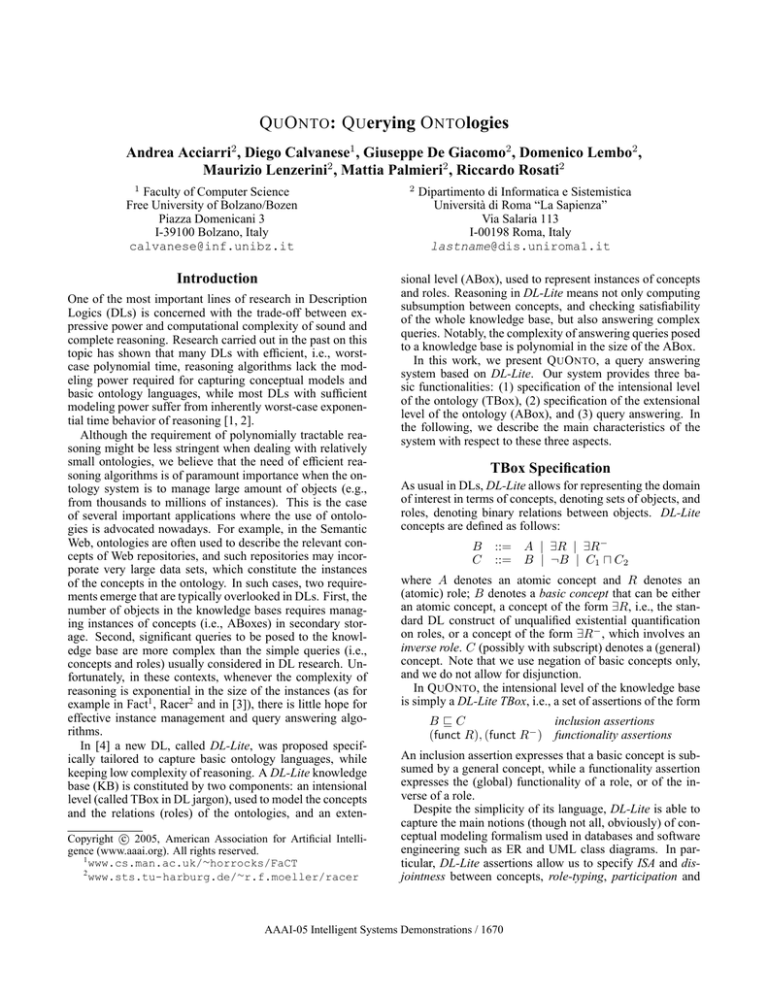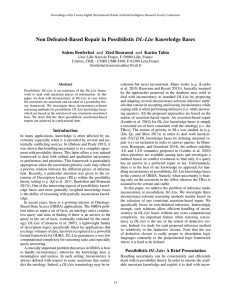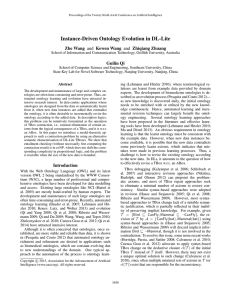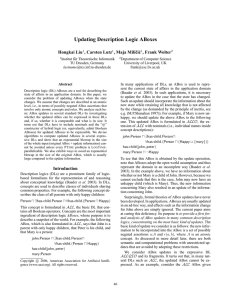
Q U O NTO: Q Uerying O NTOlogies
Andrea Acciarri2 , Diego Calvanese1 , Giuseppe De Giacomo2 , Domenico Lembo2 ,
Maurizio Lenzerini2 , Mattia Palmieri2 , Riccardo Rosati2
1
Faculty of Computer Science
Free University of Bolzano/Bozen
Piazza Domenicani 3
I-39100 Bolzano, Italy
calvanese@inf.unibz.it
Introduction
One of the most important lines of research in Description
Logics (DLs) is concerned with the trade-off between expressive power and computational complexity of sound and
complete reasoning. Research carried out in the past on this
topic has shown that many DLs with efficient, i.e., worstcase polynomial time, reasoning algorithms lack the modeling power required for capturing conceptual models and
basic ontology languages, while most DLs with sufficient
modeling power suffer from inherently worst-case exponential time behavior of reasoning [1, 2].
Although the requirement of polynomially tractable reasoning might be less stringent when dealing with relatively
small ontologies, we believe that the need of efficient reasoning algorithms is of paramount importance when the ontology system is to manage large amount of objects (e.g.,
from thousands to millions of instances). This is the case
of several important applications where the use of ontologies is advocated nowadays. For example, in the Semantic
Web, ontologies are often used to describe the relevant concepts of Web repositories, and such repositories may incorporate very large data sets, which constitute the instances
of the concepts in the ontology. In such cases, two requirements emerge that are typically overlooked in DLs. First, the
number of objects in the knowledge bases requires managing instances of concepts (i.e., ABoxes) in secondary storage. Second, significant queries to be posed to the knowledge base are more complex than the simple queries (i.e.,
concepts and roles) usually considered in DL research. Unfortunately, in these contexts, whenever the complexity of
reasoning is exponential in the size of the instances (as for
example in Fact1 , Racer2 and in [3]), there is little hope for
effective instance management and query answering algorithms.
In [4] a new DL, called DL-Lite, was proposed specifically tailored to capture basic ontology languages, while
keeping low complexity of reasoning. A DL-Lite knowledge
base (KB) is constituted by two components: an intensional
level (called TBox in DL jargon), used to model the concepts
and the relations (roles) of the ontologies, and an extenc 2005, American Association for Artificial IntelliCopyright °
gence (www.aaai.org). All rights reserved.
1
www.cs.man.ac.uk/∼horrocks/FaCT
2
www.sts.tu-harburg.de/∼r.f.moeller/racer
2
Dipartimento di Informatica e Sistemistica
Università di Roma “La Sapienza”
Via Salaria 113
I-00198 Roma, Italy
lastname@dis.uniroma1.it
sional level (ABox), used to represent instances of concepts
and roles. Reasoning in DL-Lite means not only computing
subsumption between concepts, and checking satisfiability
of the whole knowledge base, but also answering complex
queries. Notably, the complexity of answering queries posed
to a knowledge base is polynomial in the size of the ABox.
In this work, we present Q U O NTO, a query answering
system based on DL-Lite. Our system provides three basic functionalities: (1) specification of the intensional level
of the ontology (TBox), (2) specification of the extensional
level of the ontology (ABox), and (3) query answering. In
the following, we describe the main characteristics of the
system with respect to these three aspects.
TBox Specification
As usual in DLs, DL-Lite allows for representing the domain
of interest in terms of concepts, denoting sets of objects, and
roles, denoting binary relations between objects. DL-Lite
concepts are defined as follows:
B
C
::= A | ∃R | ∃R−
::= B | ¬B | C1 u C2
where A denotes an atomic concept and R denotes an
(atomic) role; B denotes a basic concept that can be either
an atomic concept, a concept of the form ∃R, i.e., the standard DL construct of unqualified existential quantification
on roles, or a concept of the form ∃R− , which involves an
inverse role. C (possibly with subscript) denotes a (general)
concept. Note that we use negation of basic concepts only,
and we do not allow for disjunction.
In Q U O NTO, the intensional level of the knowledge base
is simply a DL-Lite TBox, i.e., a set of assertions of the form
BvC
inclusion assertions
(funct R), (funct R− ) functionality assertions
An inclusion assertion expresses that a basic concept is subsumed by a general concept, while a functionality assertion
expresses the (global) functionality of a role, or of the inverse of a role.
Despite the simplicity of its language, DL-Lite is able to
capture the main notions (though not all, obviously) of conceptual modeling formalism used in databases and software
engineering such as ER and UML class diagrams. In particular, DL-Lite assertions allow us to specify ISA and disjointness between concepts, role-typing, participation and
AAAI-05 Intelligent Systems Demonstrations / 1670
non-participation constraints between a concept and a role,
and functionality restrictions on roles.
ABox Specification
In Q U O NTO, the extensional level of the knowledge base is
simply a DL-Lite ABox, i.e., a set of assertions of the form
A(c), R(c, b),
membership assertions
where c and b are constants. These assertions state respectively that the object denoted by c is an instance of the
atomic concept A, and that the pair of objects denoted by
(c, b) is an instance of the role R.
One of the distinguishing feature of Q U O NTO is that the
ABox is stored under the control of a DBMS, in order to
effectively manage objects in the knowledge base by means
of an SQL engine. To this aim, Q U O NTO constructs a relational database which faithfully represents an ABox A: for
each atomic concept A, a relational table tab A of arity 1 is
defined, such that hci ∈ tab A iff A(c) ∈ A, and for each
role R, a relational table tab R of arity 2 is defined, such that
hc, bi ∈ tab R iff R(c, b) ∈ A. We denote with DB(A) the
relational database thus constructed.
Query answering
Perhaps, the main feature of our system is the ability to
answer conjunctive queries posed to an ontology. While
virtually all DL-based systems allow for answering atomic
queries only (i.e., queries constituted by concepts or roles),
Q U O NTO is able to answer conjunctive queries over a DL
knowledge base.
A conjunctive query (CQ) q over a knowledge base K is
an expression of the form
q(~x) ← ∃~y .conj (~x, ~y )
where ~x are the so-called distinguished variables, ~y are existentially quantified variables called the non-distinguished
variables, and conj (~x, ~y ) is a conjunction of atoms of the
form A(z), or R(z1 , z2 ), where A and R are respectively an
atomic concept and a role in K, and z, z1 , z2 are onstants in
K or variables in ~x or ~y .
A conjunctive query q(~x) ← ∃~y .conj (~x, ~y ) is interpreted in an interpretation I for K as the set q I of tuples ~c
such that when we substitute the variables ~x with the constants ~c, the formula ∃~y .conj (~x, ~y ) evaluates to true in I.
Answering a conjunctive query q posed to a knowledge base
K means computing the set of tuples ~c of constants of K
such that in every model I of K we have ~c ∈ q I .
Answering conjunctive queries over a knowledge base is
a challenging problem, even in the case of DL-Lite, where
the combination of allowable constructs does not pose particular difficulties in computing subsumption. Notice that,
in spite of the simplicity of DL-Lite TBoxes, the ability of
taking TBox knowledge into account during the process of
answering conjunctive queries goes beyond the “variablefree” fragments of first-order logic represented by DLs.
In order to take advantage of the fact that the ABox is
managed in secondary storage by a Data Base Management
System (DBMS), our query answering algorithm is based
on the idea of reformulating the original query into a set of
queries that can be directly evaluated by an SQL engine over
the ABox. Note that this allow us to take advantage of well
established query optimization strategies.
Query reformulation is therefore at the heart of our query
answering method. Given the limited expressive power of
DL-Lite TBoxes, it might seem that in order to answer a
query q over a KB K constituted by a TBox T and an ABox
A, we could simply build a finite first-order structure on the
basis of K, and then evaluate the query as an expression over
this first-order structure. Actually, it is possible to show that
this is not the case. In particular, it can be shown that, in
general, given a KB K, there exists no finite structure S such
that, for every conjunctive query q, the set of answers to q
over K is the result of evaluating q over S. This property
demonstrates that answering queries in DL-Lite goes beyond
both propositional logic and relational databases. The basic
idea of our method is to reformulate the query taking into
account the TBox: in particular, given a query q over K,
we compile the assertions of the TBox into the query itself,
thus obtaining a new query q 0 . Such a new query q 0 is then
evaluated over the ABox of K, as if the ABox were a simple
relational database. Since the size of q 0 does not depend on
the ABox, the data complexity of the whole query answering
algorithm is polynomial.
Finally, we observe that query answering can be used
in Q U O NTO for other forms of reasoning on the knowledge base K. For example, to check whether K is unsatisfiable, we can simply add the assertion A(c) to the Abox
(where c is new constant), the inclusion A v ¬D to the
TBox, and check whether c is in the answer to the query
q(x) ← D(x). Similarly, to check whether K |= A v C,
we can simply add the assertion A(c) to the Abox (where c
is new constant), and check whether c is in the answer to the
query q(x) ← C 0 (x), where C 0 is the conjunctive query
corresponding to the concept C.
Conclusions
Our experiments on Q U O NTO are extremely encouraging.
The system is able to efficiently answer complex conjunctive queries (actually, unions of conjunctive queries) over
ABoxes constituted by hundreds of thousands of instances
of the concepts in the TBox. To the best of our knowledge,
this is the first system exhibiting the ability to effectively
answer complex queries over ontologies.
References
[1] F. Baader, D. Calvanese, D. McGuinness, D. Nardi, and P. F.
Patel-Schneider, editors. The Description Logic Handbook:
Theory, Implementation and Applications. Cambridge University Press, 2003.
[2] A. Borgida and R. J. Brachman. Conceptual modeling with
description logics. In Baader et al. [1], chapter 10, pages 349–
372.
[3] D. Calvanese, G. De Giacomo, and M. Lenzerini. Answering
queries using views over description logics knowledge bases.
In Proc. of AAAI 2000, pages 386–391, 2000.
[4] D. Calvanese, G. De Giacomo, M. Lenzerini, R. Rosati, and
G. Vetere. DL-Lite: Practical reasoning for rich DLs. In Proc.
of DL 2004. CEUR Electronic Workshop Proceedings, http:
//ceur-ws.org/Vol-104/, 2004.
AAAI-05 Intelligent Systems Demonstrations / 1671







